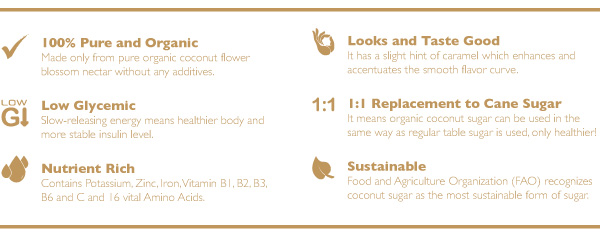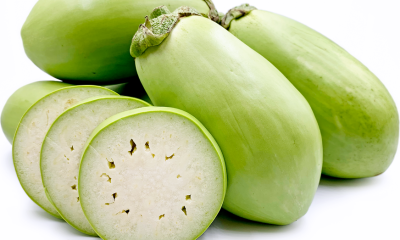Health
6 benefits of coconut sugar and side effects

Discover the 6 benefits of coconut sugar and side effects.
Coconut sugar is a natural sweetener that can be more expensive than regular granulated sugar, but it’s worth it as it yields some tremendous benefits that make it a much better choice than many other sweetener options.
For example, coconut sugar is better for diabetics and the gut than regular, everyday sugar, and it contains small amounts of vitamins and minerals.
We can thank the coconut tree for the many products it produces, from coconut water to desiccated coconut, coconut vinegar, and as a personal favorite, coconut oil.
It is also very popular in the manufacture of alcoholic beverages known by the locals as a tuba or coconut wine.
However, it is the inflorescence – of coconut flowers of the coconut tree (not to be confused with the palm tree) – that offers a sap that can be processed to create a syrup or honey-like substance, which is then dried to form coconut sugar.
Benefits of coconut sugar
1.- It can help diabetics
Coconut sugar and coconut nectar contain a fiber known as inulin. This fiber can help slow glucose absorption, offering an alternative for those dealing with diabetic concerns; Some studies show that inulin can help reduce glucose absorption, therefore keeping glucose levels in check.
One particular study conducted suggests that the benefits of coconut sugar help women with type 2 diabetes, improving some glycemic and antioxidant levels while lowering levels of malondialdehyde, a marker of oxidative stress.
Tasting similar to brown sugar, coconut sugar (and coconut nectar) is gaining popularity as a sweetener in everything from coffee and tea to delicious food recipes.
The American Diabetes Association shares that while people with diabetes can use coconut sugar as a sweetener in a diabetic diet plan, they must use it the same way they would use table sugar because it contains as many calories and carbohydrates as possible. possible.
Approximately 15 calories and four grams of carbohydrates per teaspoon. Another important note is that it is often found mixed with table sugar, so take a look at the label before making a purchase.
2.- Tested by the Paleo diet
If you’re following the Paleo diet, coconut sugar is one option you can use to satisfy that sweet tooth, according to the Ultimate Paleo Guide; Some hardcore Paleo followers still avoid it as it is often processed.
However, it is believed to have been used in the Paleolithic, which is part of their claim that it is fine for Paleo lovers.
Studies lead us to think that our ancestors got about 35% of their dietary energy from fat, 35% from carbohydrates, and 30% from protein.
The benefits of coconut sugar would be in the carbohydrate category, but it is still a processed form of the coconut flower; perhaps coconut nectar or a liquid form is a bit closer to Paleo for those who want to maintain a stricter paleo lifestyle.
3.- Contains vitamins, minerals, and phytonutrients
Coconut sugar contains vitamins, minerals, and phytonutrients, albeit in small amounts. For example, both the zinc and the iron that is found in the benefits of coconut sugar contain at least twice as much as what we can find in traditional or granulated sugar.
The FNRI also notes that there is a decent amount of phytonutrients, specifically polyphenols, flavonoids, and anthocyanidins.
These phytonutrients help lower blood sugar, inflammation, and cholesterol, making coconut sugar a better choice than many other sweeteners.
The American Cancer Society explains that phytonutrients from plants offer many health benefits and are better options than supplements or pills.
4.- Good for the digestive system
As noted above, coconut sugar benefits contain inulin, which, among other things, has within its capabilities the stimulation of so-called intestinal bifidobacteria growth, which is usually found within probiotics, which can provide a boosted general to the immune system.
As you know, bifidobacteria make up a select group of bacteria that normally live inside the intestines, and that can grow outside the body and be taken orally like any medicine.
Bifidobacteria are known to help restore the good bacteria in the gut that may have been destroyed through chemotherapy, antibiotics, and the like.
This bacterium helps many conditions that can affect the intestines, including diarrhea, ulcerative colitis, and pouchitis, and has even been used to prevent a particular intestinal infection found in infants called necrotizing enterocolitis.
Side effects of coconut sugar
There seems to be little information regarding precautions other than the reminder that coconut sugar has the same calories as regular sugar, so keeping it in moderation is key.
Having too much sugar of any kind can affect weight gain, and inflammation in the body, and can even increase the risk of cardiovascular disease.
Additionally, the American Diabetes Association notes that many products on the shelf add regular sugar to coconut sugar, so it’s important to keep an eye on labeling.
How to make use of coconut sugar
Coconut sugar can be used the same way regular sugar is used, but you may want to start with half the amount until your desired sweetness is reached.
Coconut palms have been used for sugar production for centuries using sophisticated tapping techniques that were developed in Asia, Africa, and the Americas.
Ensuring ways to recover the sap has been of great interest since animal feeding trials were successfully started during a project in Cambodia.
This process has been practiced by Indonesians for hundreds of years and is noted as an efficient system on some highly populated islands.
It is commonly known as coconut sugar, coconut palm sugar, coconut sap sugar, or coconut blossom sugar, but note that palm sugar is not the same thing and is often confused when used in labeling.
Is coconut sugar good for human consumption?
This question is very popular, especially since coconut oil has become one of the main stimulants for almost anything, from whitening your teeth to a healthy fat in your morning toast, but there is still little data on it.
What we do know is that there are trace amounts of vitamins and minerals found in coconut sugar, but for you to have impactful nutrition, you need to eat a lot of it.
Eating too much sugar, in any form, is not a good idea, and coconut sugar, calorie for calorie, is the same as regular granulated sugar.
In any case, it is the best option if you are looking for an alternative sweetener or granulated sugar substitute, as there are trace elements available, such as iron, zinc, calcium, potassium, some short-chain fatty acids, polyphenols, antioxidants, and fiber is known as inulin, all of which may offer some health benefits that regular table sugar cannot.
Final Thoughts
Coconut sugar can be a great sugar alternative, especially for diabetics.
Also, while coconut sugar has many benefits that you won’t find in regular table sugar, it may require large amounts to have a positive effect.
Regardless, it’s a much better option than regular granulated sugar, though keep in mind that I always recommend opting for small amounts of sugar in your overall diet.
However, if you’re going for that sweetener, coconut sugar is one of the best natural sweeteners out there.
Health
13 Benefits of sorrel and side effects

Table of Contents
Health
Benefits of hyaluronic acid for acne

- Methods of treatment
- FREQUENT QUESTIONS
- What is the main indication of hyaluronic acid in acne scars?
- When is the effect of hyaluronic acid noticeable?
- How is hyaluronic acid applied?
- How many hyaluronic acid sessions are needed to treat facial acne scars?
- How is the face after doing the filling session?
- Is it a painful procedure?
- Can fillers be combined with other acne scar treatments?
- Is the effect of hyaluronic acid definitive?
Discover the benefits of hyaluronic acid for acne.
In most acne scars there is a loss of skin volume ( atrophy ), which gives the area where they form a depressed or “engraved” appearance.
This atrophy is the product of a lack of hyaluronic acid and collagen in the dermis, the intermediate part of the skin, responsible for giving the turgidity, volume, and elasticity of healthy skin.
Methods of treatment
There are different methods to treat atrophic scars, which we could classify into two different groups according to their speed of action:
· Immediate effect. They are called fillers, biocompatible substances that can be injected into the skin to give volume to areas that have lost it.
Among them, those of hyaluronic acid, polylactic acid, or calcium hydroxyapatite stand out among others. Its turgid effect is immediate, filling cavities, furrows, and atrophic areas of the skin with very natural results. The duration of these materials is limited, so periodically (every 6 – 18 months ) it is common to practice a new session.
· Delayed effect. It implies that they promote the synthesis of collagen and ground substance of the dermis. It is worth mentioning the fractional lasers (ablative or non-ablative) and the intermediate and deep peels.
The main advantage of these methods is that their effect is permanent once the optimal point of improvement has been reached, which is not immediate but after practicing several sessions of the procedure.
Hyaluronic acid is indicated in the treatment of atrophic, depressed, and ice-pick acne scars. There are different densities of hyaluronic acid, designed to treat different forms of atrophy or loss of volume.
For the treatment of moderate or ice pick acne scars, it is useful to use low and intermediate densities; and to recover a large volume in especially atrophic areas, it is possible to use higher densities to cover the maximum repertoire of defects.
The main advantages of using hyaluronic acid lie in its immediate action, its durability, its biocompatibility, and its minimal allergenic potential. This molecule can fill in atrophic scars, providing optimal volume immediately and in the short term, promoting collagen synthesis in the long run.
In this way, the irregularity on the surface of the skin is substantially reduced after the application of hyaluronic acid, improving the overall appearance of the skin in the treated area.
Another positive aspect of using hyaluronic acid is that it usually only requires a single application session. Likewise, fillers are one of the best tolerated aesthetic procedures since they have a minimal rate of adverse effects and the pain caused is minimal if a precise technique is followed. Slight erythema (redness) that lasts 2-4 hours after the procedure is common and can be reduced with the application of cold compresses.
According to studies published by Halachmi et al, the satisfaction rate and results in patients with atrophic acne scars and ice pick treated with hyaluronic acid are excellent.
The only limiting aspect of hyaluronic acid fillers is their duration. This molecule is naturally degraded in the skin, its effect persisting for 6-18 months depending on the density of hyaluronic acid used and the indication for which it has been applied.
Specifically, for acne scars, the duration of hyaluronic acid is the maximum possible, since it is retained within the fibrosis that partitions the scars. It should be remembered that, in the long term, this molecule favors the synthesis of collagen, so that the perceptible effect is progressively more durable as different sessions are carried out.
FREQUENT QUESTIONS
What is the main indication of hyaluronic acid in acne scars?
Its main effect is to fill in depressed scars and regularize the appearance of the skin surface.
When is the effect of hyaluronic acid noticeable?
The effect of hyaluronic acid is immediate and noticeable at the end of its application. Over a week or so, the hyaluronic acid settles in the applied area and the surface where it has been applied progressively becomes even more regular.
How is hyaluronic acid applied?
The procedure is performed in the Dermatology consultation through microinjections applied under the scars to be treated. An anesthetic cream is usually used before the session and it is very tolerable, with minimal discomfort.
How many hyaluronic acid sessions are needed to treat facial acne scars?
In general, if they are not very deep or extensive, one is enough.
How is the face after doing the filling session?
The corrective effect of hyaluronic acid is immediate. At the end of the session, most atrophic and depressed scars have recovered all or part of their lost volume. Immediately after the session, it is usual to see some redness in the treated areas and slight swelling, which usually lasts between 2-4 hours.
It is possible, although infrequent, that during the procedure a minimal punctual hematoma may appear in an injection area, which will disappear spontaneously over a week or so.
Is it a painful procedure?
Filling with hyaluronic acid after application of anesthetic cream is one of the most well-tolerated and appreciated aesthetic procedures, with an excellent satisfaction rate for the patient.
Can fillers be combined with other acne scar treatments?
Yes. They can be used concomitantly with ablative/non-ablative peels or lasers, or even botulinum toxin if desired. It is recommended, yes, to carry them out in different sessions.
Is the effect of hyaluronic acid definitive?
No. Although with each session there is a certain accumulation of the effect due to the collagen synthesis promoted by hyaluronic acid, it is advisable to perform a filler every 6-18 months depending on the indication and the area to be treated.
Health
10 Benefits Of Feijoa Or Pineapple Guava

Table of Contents
- What is feijoa or pineapple guava?
- Knowing the flavor of feijoa
- Nutritional contributions of feijoa.
- 10 health benefits of feijoa.
- How to eat feijoa?
- Discover the 10 Benefits Of Feijoa Or Pineapple Guava.
Feijoa can have a wide range of health effects, including aiding weight loss, improving digestion, lowering cholesterol levels, boosting the immune system, increasing bone strength, lowering blood pressure, optimizing nutrient absorption, balance metabolism, increase circulation, stimulate cognitive function and regulation of blood sugar levels, among other benefits of feijoa.
There are very few reported side effects, although allergies to this fruit do exist, and some reports of gastrointestinal problems and low blood sugar levels have been documented.
That said, for most people who consume this fruit in moderation, it offers far more health benefits than side effects, so there’s no running away from the benefits of feijoa.
What is feijoa or pineapple guava?
Feijoa has another name in many parts of the world: pineapple guava. Scientifically known as Acca sellowiana, the plant that produces this fruit is a shrub or small tree native to regions of South America, such as Argentina, Brazil, and Colombia. It is now widely cultivated for its sweet fruit, as well as for ornamental purposes.
The fruit is green and ellipsoid-shaped and is about the size of a plum or a small avocado.
The unique flavor and impressive supply of nutrients make feijoa highly sought after as it can have many different culinary applications, from an ingredient in smoothies to cocktails, desserts, chutneys, and cooked fruit dishes.
Knowing the flavor of feijoa
Feijoa has a very unique flavor, with sweet, sour, and bitter elements, which many people compare to guavas and pineapples, as its common name implies, but it also has a slight strawberry flavor. In some cultivars, there are very subtle notes of mint, which can increase as the fruit ripens.
To ensure the best flavor and flavor of the feijoa, the fruits should be collected the day they fall from the tree, as this indicates the ideal ripeness.
Before that, the taste is more bitter, while after the fruit falls, it can become too ripe and unpleasant to eat.
Nutritional contributions of feijoa.
Whether you are eating the fruit for its benefits or its exotic flavor, you will benefit from its impressive nutrient content.
The calorie content per serving (100 grams) is just 55, which is unusually low, this tropical fruit also contains significant levels of vitamin C (over 50% of your daily recommendation per serving), as well as a diverse selection of B vitamins. and traces of vitamin E, K, and A.
In terms of mineral content, feijoa contains moderate levels of copper, manganese, magnesium, potassium, iron, and calcium.
A single serving of this fruit also delivers more than 15% of your recommended daily dietary fiber, in addition to various phytochemicals, phenols, and antioxidants.
10 health benefits of feijoa.
People who regularly consume this fruit to make themselves available to the benefits of feijoa will receive health favors related to blood pressure, cholesterol, obesity, immune health, oxidative stress, metabolism, osteoporosis, indigestion, diabetes, circulation, cognitive function, and nutritional deficiencies.
1.- Increase immunity
With a strong supply of vitamins and minerals in the fruit, the benefits of feijoa allow regular consumption to give your immune system a much-needed boost.
Vitamin C can stimulate the production of white blood cells, the body’s first line of defense, while also acting as an antioxidant to search for free radicals; a single serving of pineapple guava has more than 50% of your recommended daily vitamin C.
2.- Regulates blood pressure
Potassium-rich foods are important for people who suffer from high blood pressure and therefore are at high risk for cardiovascular disease, atherosclerosis, and stroke.
Potassium is a vasodilator, which means that it can reduce stress on blood vessels and arteries, and generally relieve stress on the cardiovascular system.
3.- Digestion AIDS
High levels of dietary fiber (about 17% of your recommended daily fiber per serving) mean that this fruit is capable of optimizing digestion by stimulating peristaltic movement and enhancing nutrient absorption.
This can help ease symptoms of indigestion, constipation, bloating, cramps, and a general upset stomach.
4.- Reduces cholesterol
In addition to improving digestion, dietary fiber is also directly linked to lower cholesterol levels, particularly “bad” cholesterol, which can increase your risk of heart disease.
By removing this cholesterol from the arteries and blood vessels, it lowers the risk of blood clots, heart attacks, and strokes.
5.- Improve Cognition
The antioxidants present in feijoa have been associated with increased memory and retention, better focus, and a lower risk of neurodegenerative diseases, such as mental illnesses such as Alzheimer’s and dementia; antioxidants can seek out and neutralize free radicals in neural pathways before they can cause plaque buildup.
6.- Increases metabolism
The B vitamins are incredibly important for the overall functioning of the body, especially when it comes to metabolic activities such as the synthesis of proteins and red blood cells, the production of hormones, the stimulation of the functioning of the nervous system, and the generation of energy within cells. . Fortunately, feijoa benefits from moderate levels of numerous B vitamins.
7.- Improves bone strength
With significant levels of manganese, copper, iron, calcium, and potassium, this tropical fruit is very effective in increasing bone mineral density and helping prevent the onset of osteoporosis as you age. This can increase your energy levels and keep you more active and capable in your later years.
8.- Control diabetes
Research has shown that eating feijoa can help regulate blood sugar levels, due to its low level of calories and carbohydrates, which can help regulate the body’s production and release of insulin.
9.- Increase circulation
Although there is a relatively small amount of iron present in feijoa, it can still aid red blood cell production and circulation, while the metabolic boost from vitamin B can also stimulate blood flow. This means greater oxygenation in critical areas of the body and higher energy levels.
10.- Promotes weight loss
There are only 55 calories in a 100 gram serving of the feijoa, but plenty of dietary fiber and nutrients. Combined with the low level of carbohydrates, this means that the body will feel full and access a significant supply of nutrients without adding too many calories or sugar to your daily intake. This can have a positive impact on weight loss goals and avoid overeating or snacking between meals.
How to eat feijoa?
The skin of the pineapple feijoa or guava fruit is edible, but many people prefer to cut the fruit in half, such as avocado, remove the seeds, and then scoop out the soft, sweet pulp with a spoon. However, simply slicing the fruit, without removing the skin, can deliver even more dietary fiber.
The bitter taste mainly occurs near the skin of the fruit, so if you want a sweeter snack, remove the skin entirely. The fruit is at ideal maturity when the pulp of the seed is completely clear.
As this fruit tends to ripen very quickly, there may be some brown or discoloration near the center, but this does not mean that the fruit is rotten and that the creamy flesh is perfectly safe to eat.
Avoid eating pineapple guavas that are more than half golden on the inside, as they may have started to go bad.
-

 Food1 year ago
Food1 year ago10 + Benefits of carrot juice and side effects
-

 Benefits4 months ago
Benefits4 months agoThe Benefits of Joining Gym Lumolog – Improve Your Fitness & Health
-

 Health1 year ago
Health1 year ago50 Super Healthy (And Very Often Cheap) Foods
-

 Health1 year ago
Health1 year ago5 Shocking health benefits of kinkeliba and side effects
-

 Food1 year ago
Food1 year ago8 shocking benefits of leek juice and side effects
-

 Health1 year ago
Health1 year agoBenefits of guava leaves Sensually
-

 Weight Loss1 year ago
Weight Loss1 year agoChaz Bono weight loss secret
-

 Health1 year ago
Health1 year ago13 shocking health benefits of Thai eggplant












